Church of the Holy Sepulchre – Full Visitors Guide with Photos
According to tradition, the Church of the Holy Sepulchre in Jerusalem contains two of Christianity’s holiest sites. They are the Golgotha and Jesus’s empty tomb.
Table of Contents
- 1 Sepulchre Or Sepulcher?
- 2 Map
- 3 Church Plan
- 4 Directions
- 5 Opening Hours
- 6 Entrance Fee
- 7 Dress Code
- 8 Religious Significance
- 9 Ladder
- 10 Stone of Anointing
- 11 Rotunda and Aedicule
- 12 Catholicon
- 13 Lower Level
- 14 Chapel of Saint Helena
- 15 Golgotha – Calvary
- 16 Tours or Individual Visits?
- 17 How Much Time Does a Visit to the Church of the Holy Sepulchre Take?
- 18 History
- 19 Summary
Sepulchre Or Sepulcher?
In past blogs, I always wrote Sepulcher. But when I check Wikipedia, I see that they spell Sepulchre. So what is the correct form of writing?
The short answer is both. According to WikiDiff, Sepulchre and Sepulcher both mean a burial chamber. Sepulchre is the UK version, and Sepulcher is mainly the US one.

Map
Church of the Holy Sepulchre is located inside the Old City of Jerusalem in the Christian Quarter.
Directions for drivers: Link to Waze and Link to Google Maps
Directions for public transport: Link to Moovit
Interactive map of the area:
You can find the following map in several places in the Old City of Jerusalem.
Note: You can click on the map to enlarge it.
On the map above, the Church of the Holy Sepulchre is located in squares G5 and G6. If you are looking for a map of the church’s interior, please see the following section.
Church Plan
So far, we have seen the map of the area. But what about the church itself?
We recently visited the Tel Aviv Museum of Art and saw the “In Statu Que” exhibition. This exhibition discussed negotiations of different structures, one of which was the Church of the Holy Sepulchre. So in this section, I want to show several photos from “In Statu Que.”
Let’s begin with the model of the church.
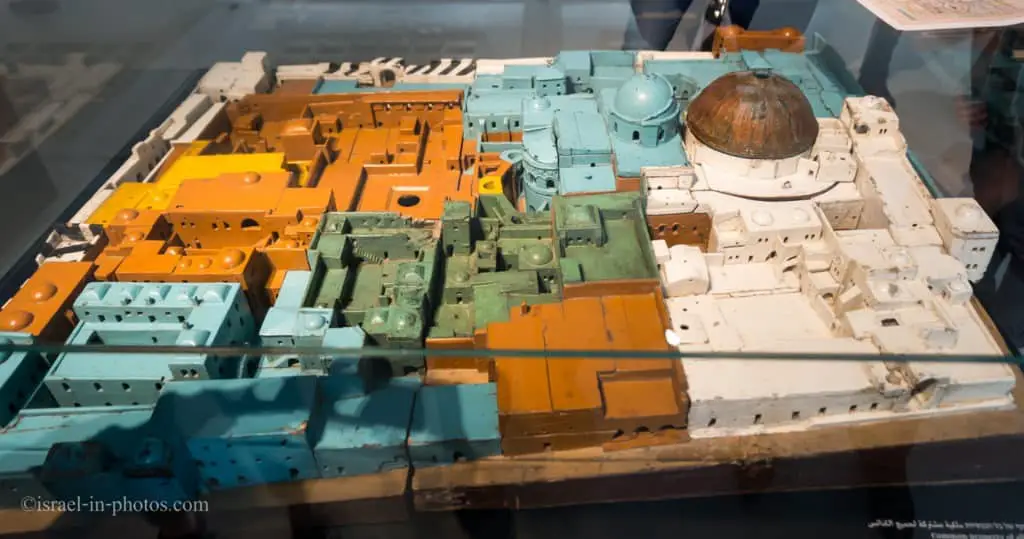
In the model above, each church block has a different color.
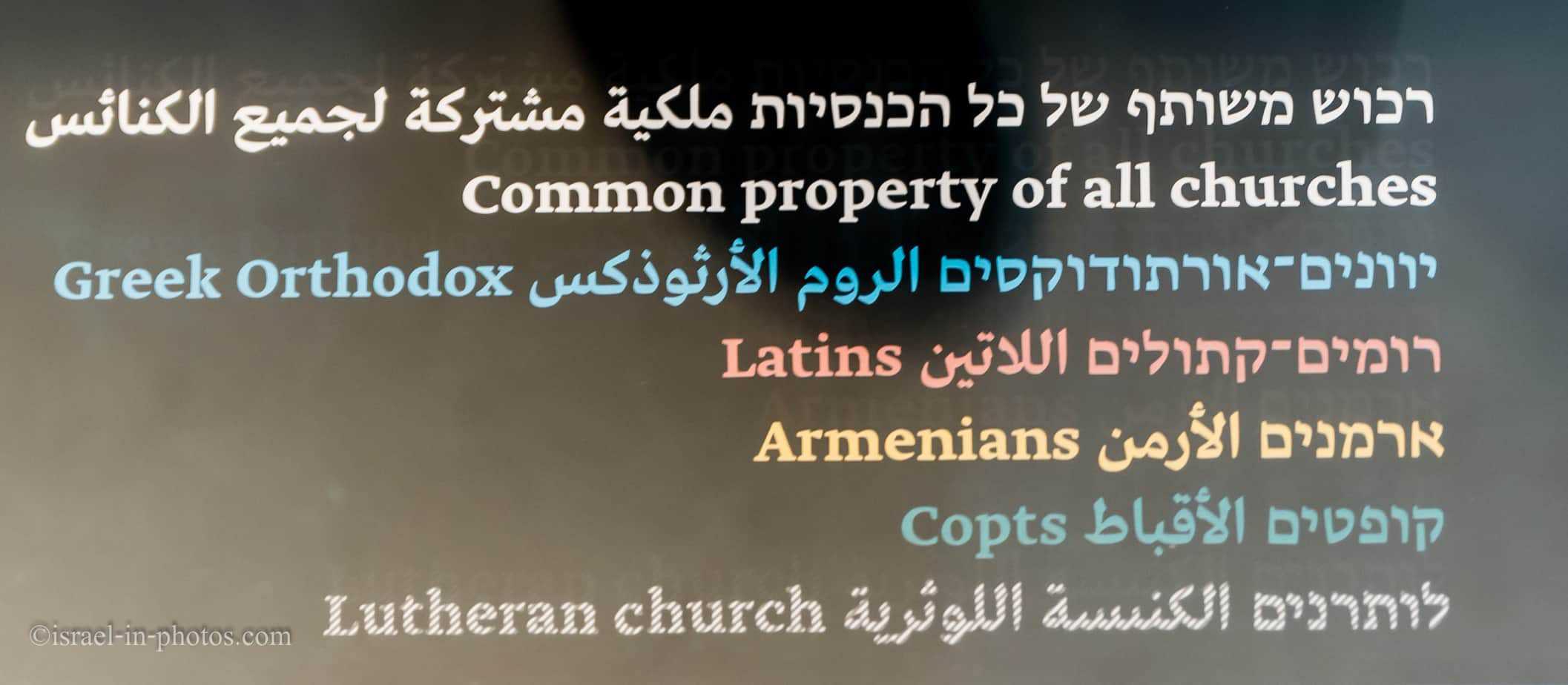
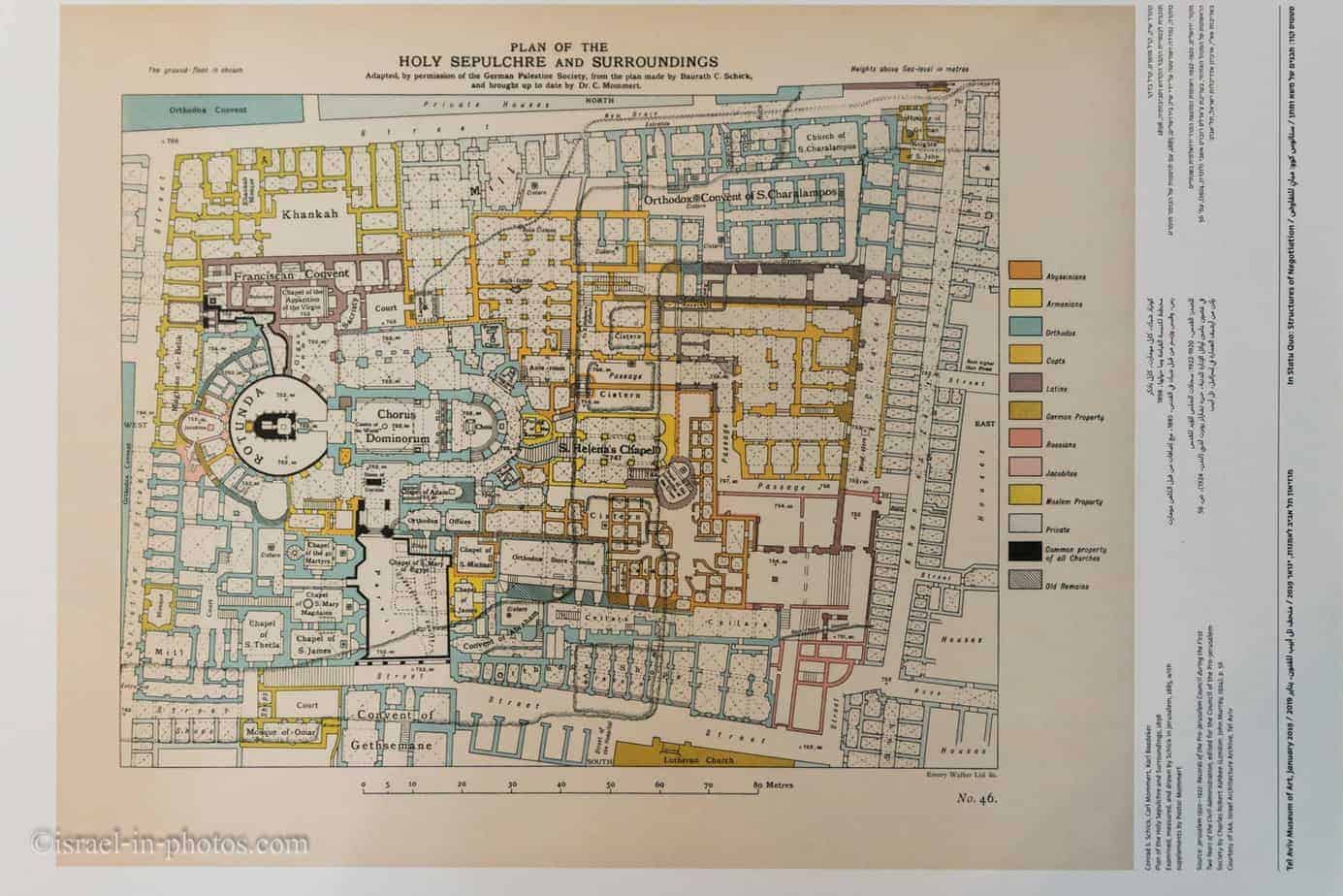
Note: You can click on the image to enlarge it.
Directions
My favorite way to reach the Old City is by using the Park and Ride system. Park and Ride mean leaving your car at one of the free parking lots near the Jerusalem Light Rail (in my case, and if you are arriving from the center of Israel, it is the Ammunition Hill parking). And then take the Jerusalem Light Rail to City Hall station. The City Hall, located at Safra square, is a short walk from the Jaffa gate.
In my guide to the Old City, you will find other suggestions for reaching the Old City and the Church Of The Holy Sepulchre.
Jaffa gate and Damascus gate are the closest to the Church Of The Holy Sepulchre, but since the Old City is relatively small, you can reach it from any entrance. Usually, we enter from the Jaffa gate and continue straight to the market. Once you enter the market, you proceed straight to Muristan street (third turn to the left). On Muristan street, you will see the Church of the Redeemer. After it, you turn left to Saint Helena Street.
The compound of the Church Of The Holy Sepulchre has two entrances. The one I mentioned above (from the directions of the Church of the Redeemer) is the more common one. You can also enter the church from Christian Quater street (it is helpful if you are looking for a faster way and not through the market to Jaffa gate).
Opening Hours
I have checked three websites, and all listed the same opening hours. And they are:
April – September
Monday – Saturday: 05:00 – 21:00
Sunday: 05:00 – 20:00
October – March
Daily: 04:00 – 19:00
When to Visit the Church Of The Holy Sepulchre?
Unless the hours were changed recently, my experience suggests shorter opening hours. About a year ago, we were in the Old City, and at around 18:00, the Church Of The Holy Sepulchre was already closed. Thus I would suggest arriving earlier. Moreover, since the church is usually crowded (especially during Easter), I recommend coming early. At around 10:00 in the morning, you will see that tourist groups start to arrive. Thus, if you prefer fewer people (and spend less time waiting in line), visit before 10:00 (preferably before 9:00).
Entrance Fee
Free.
Dress Code
As in all religious sites, you are requested to dress modestly. Moreover, I would suggest that women take a light scarf, which can be used to cover the head and shoulders.
Religious Significance
To understand the importance of this church, we need to explain what happened in this place before there was a church.
According to traditions, this church contains two holiest sites in Christianity. They are the Golgotha (also known as Calvary), where Jesus of Nazareth was crucified, and Jesus’s empty tomb, where he is said to have been buried and resurrected.
Within the church, proper are the last four (or, by some definitions, five) stations of the Via Dolorosa, representing the final episodes of the Passion of Jesus. The church has been a major Christian pilgrimage destination since its creation in the fourth century, as the traditional site of the resurrection of Christ, thus its original Greek name, Church of the Anastasis (‘Resurrection’).
Source: Wikipedia
Ladder
Here is a photo of the exterior. And if you take a closer look at the second-floor windows (you can click on the picture to enlarge them), you will see a ladder beneath one of them.
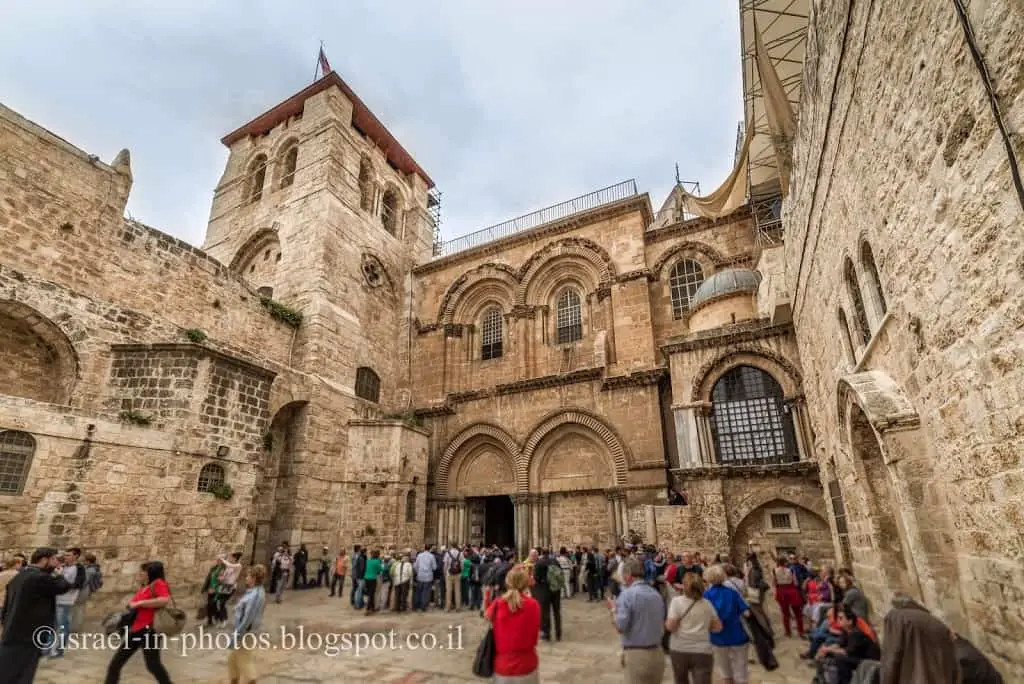
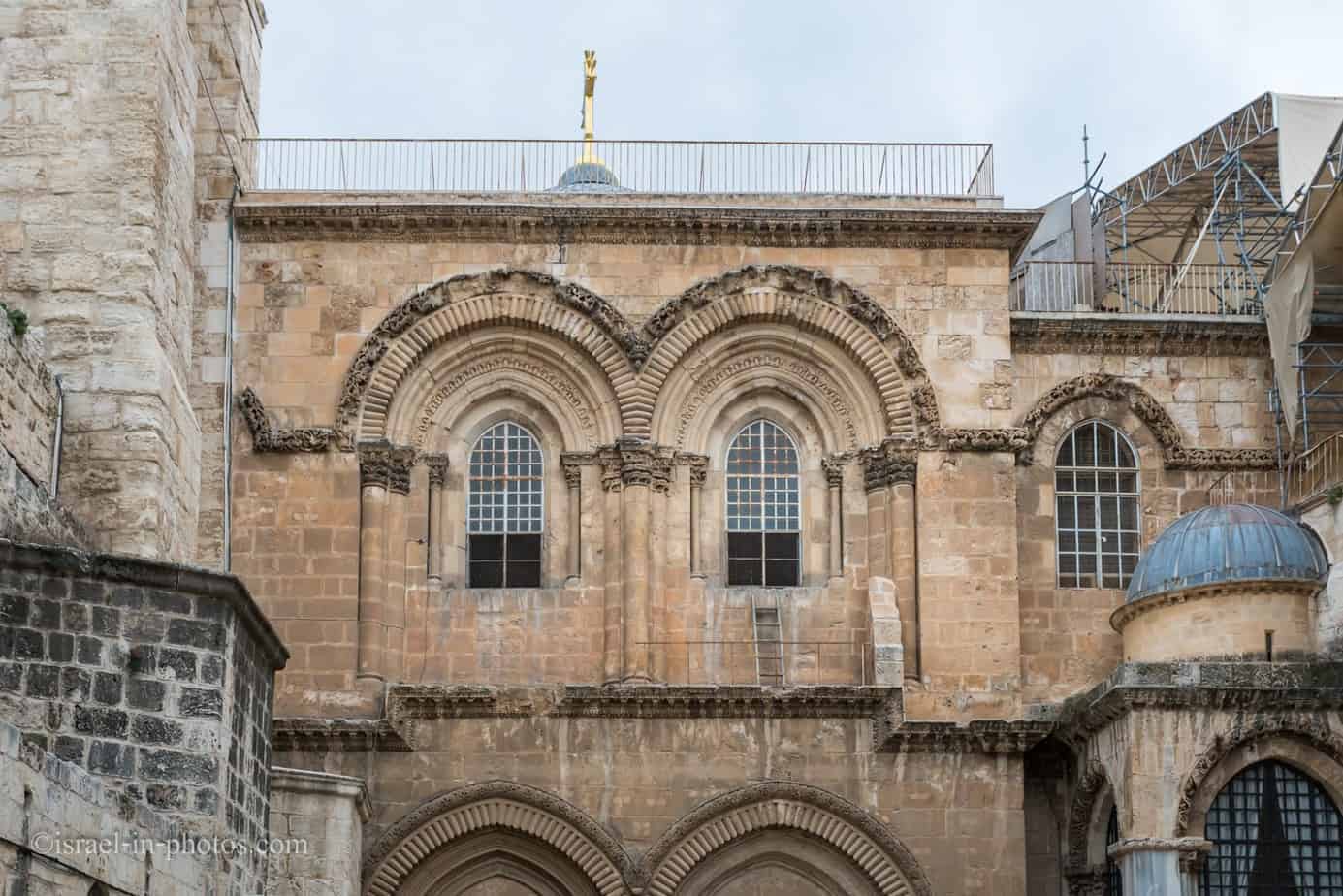
This ladder was not moved for more than 250 years. To understand why we need to discuss the Status Quo.
Status Quo
The Status Quo is an understanding among religious communities concerning nine shared religious sites in Jerusalem and Bethlehem.
The status quo stemmed from a firman (decree) of Ottoman sultan Osman III in 1757 that preserved the division of ownership and responsibilities of various Christian holy places. Further firmans issued in 1852 and 1853 affirmed that no changes could be made without consensus from all six Christian communities. The Status Quo’s actual provisions were never formally established, but the 1929 summary prepared by L. G. A. Cust, The Status Quo in the Holy Places, became the standard text on the subject.
Source: Wikipedia
Immovable Ladder
And since the Status Quo understanding, this ladder was not moved (more precisely, almost not moved).
Some consider the so-called immovable ladder under the window of the Church of the Holy Sepulchre to be a visible symbol of the alleged inactivity the Status Quo imposes. Made of Lebanon cedarwood, the ladder was in place by 1728 and has remained there ever since the 1757 status quo was established, aside from being temporarily moved twice. The ladder is referred to as immovable due to the agreement of the Status Quo that no cleric of the six ecumenical Christian orders may move, rearrange, or alter any property without the consent of the other five orders.
According to various accounts, the ladder once belonged to a mason who was doing restoration work in the Church of the Holy Sepulchre. Jerome Murphy-O’Connor states that “the ladder was first introduced at a time when the Ottomans taxed Christian clergy every time they left and entered the Holy Sepulchre.” The Catholics adapted by setting up quarters inside the church.
Source: Wikipedia
Note: I visited the Church Of The Holy Sepulchre more than a dozen times. Thus, you will see photos from different times of the day and various seasons. But in all of them, you will see crowds. Therefore, I would suggest reading the section above to determine when to visit.
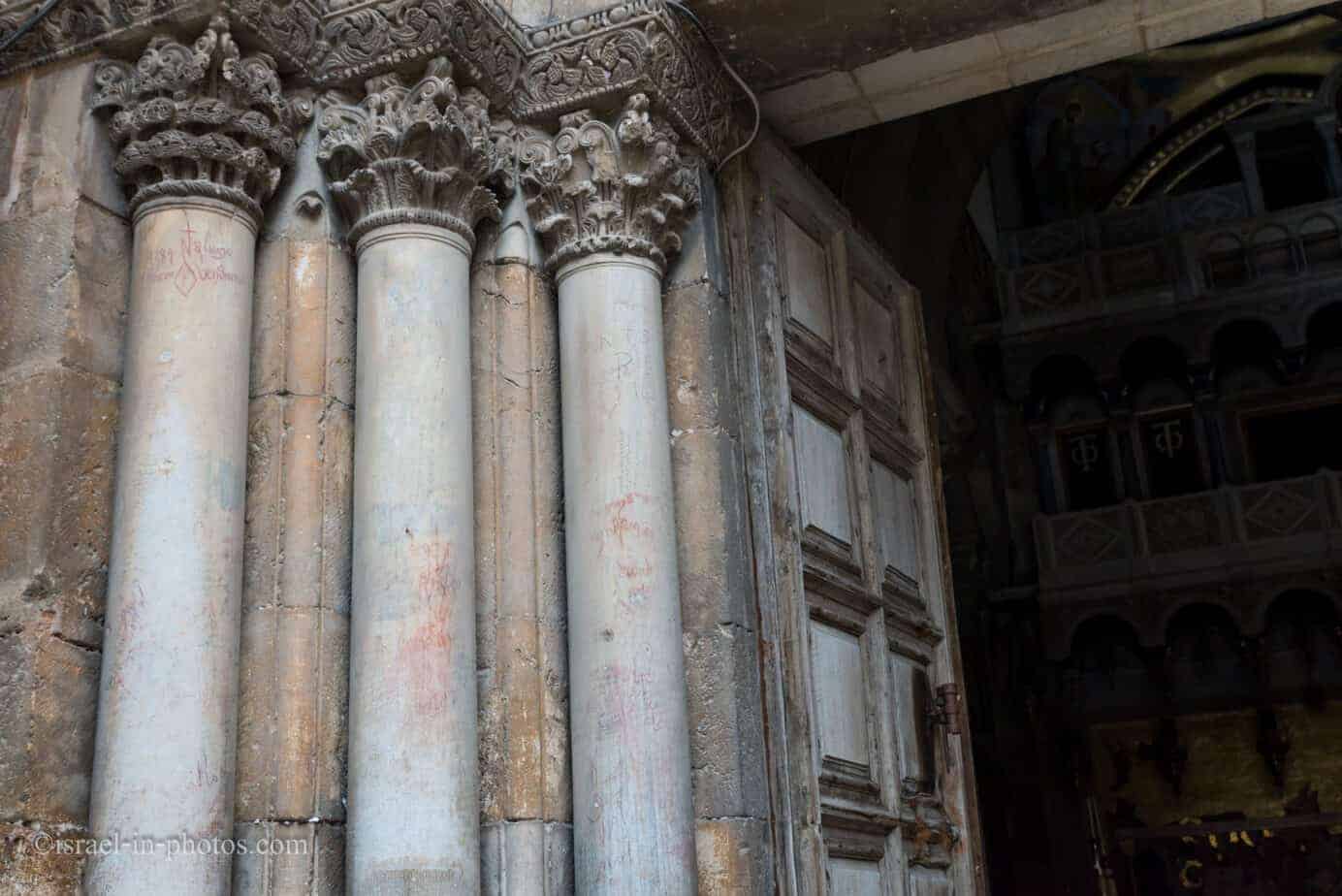
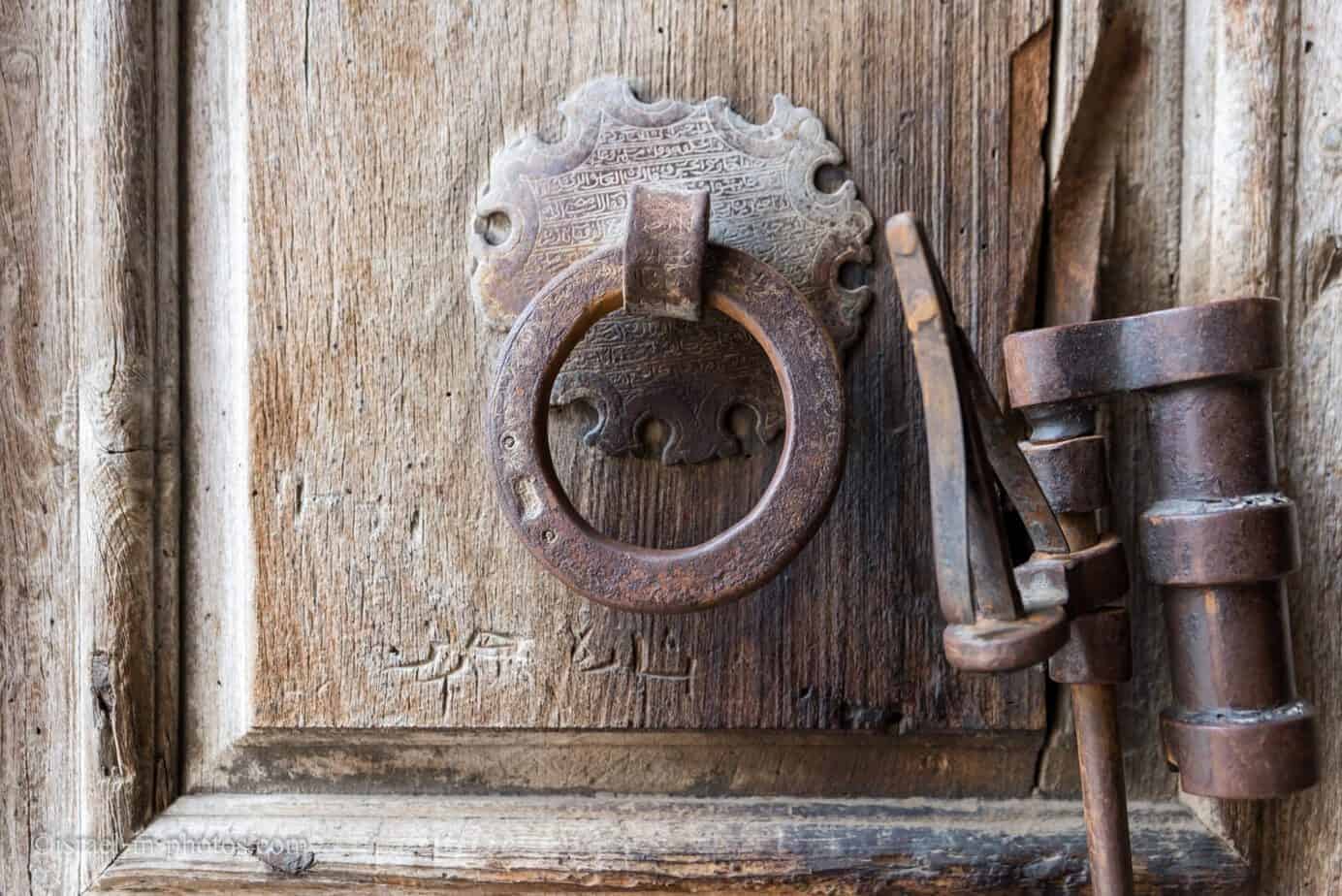
Stone of Anointing
When you enter the church, the first thing you see will probably be the Stone of Anointing. It is hard to see it behind the crowds, but it is located on the floor level about ten meters from the entrance.
The Stone of Anointing is where Jesus’s body is said to have been anointed before burial.
Just inside the entrance to the church is the Stone of Anointing, which tradition believes to be the spot where Jesus’ body was prepared for burial by Joseph of Arimathea. However, this tradition is only attested since the crusader era, and the present stone was only added in the 1810 reconstruction.
The wall behind the stone is defined by its striking blue balconies and tau cross-bearing red banners (depicting the emblem of the Brotherhood of the Holy Sepulchre) and is decorated with lamps.
The lamps that hang over the Stone of Anointing, adorned with cross-bearing chain links, are contributed by Armenians, Copts, Greeks, and Latins.
Source: Wikipedia
You can see a modern three-part mosaic on the wall behind the Stone of Anointing. Here is a panorama of the mosaic:
The mosaic shows three scenes. The pictures are (from right to left): descent from the Cross, anointing of Jesus’ body, and burial of Jesus.
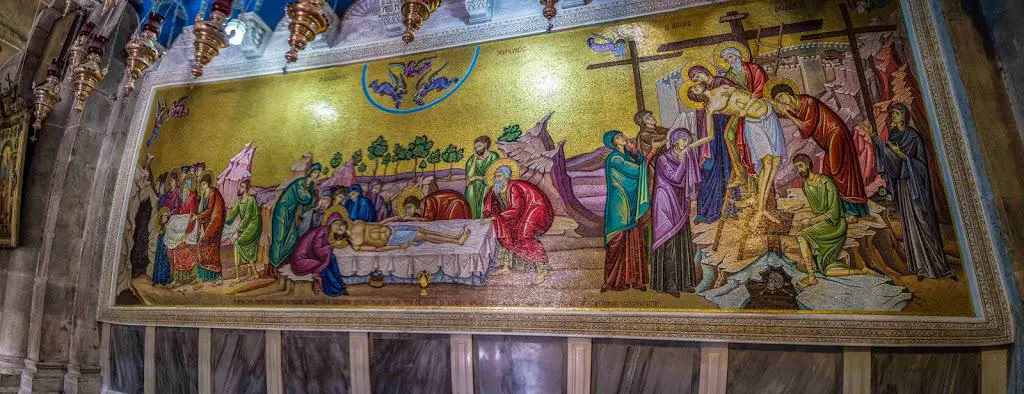
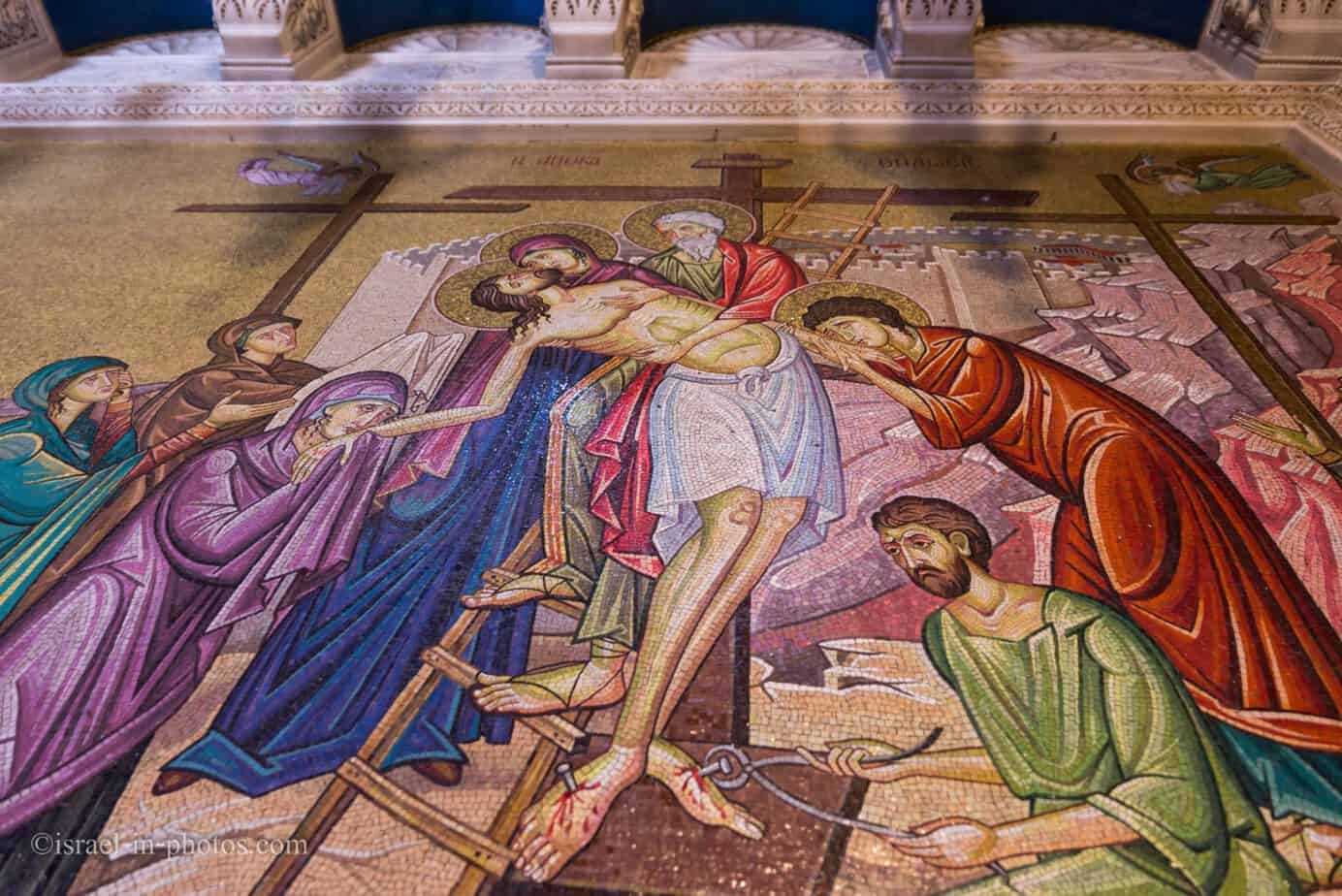
To the right of the Stone of Anointing, you can find the staircase leading to Golgotha. Further along, the same wall is the entrance to the Chapel of Adam. But we will continue to the left. Our visit will be in a clockwise direction. And we will visit Golgotha at the end. Meanwhile, I will show you how the Stone of Anointing and the entrance look from the balcony near Golgotha.
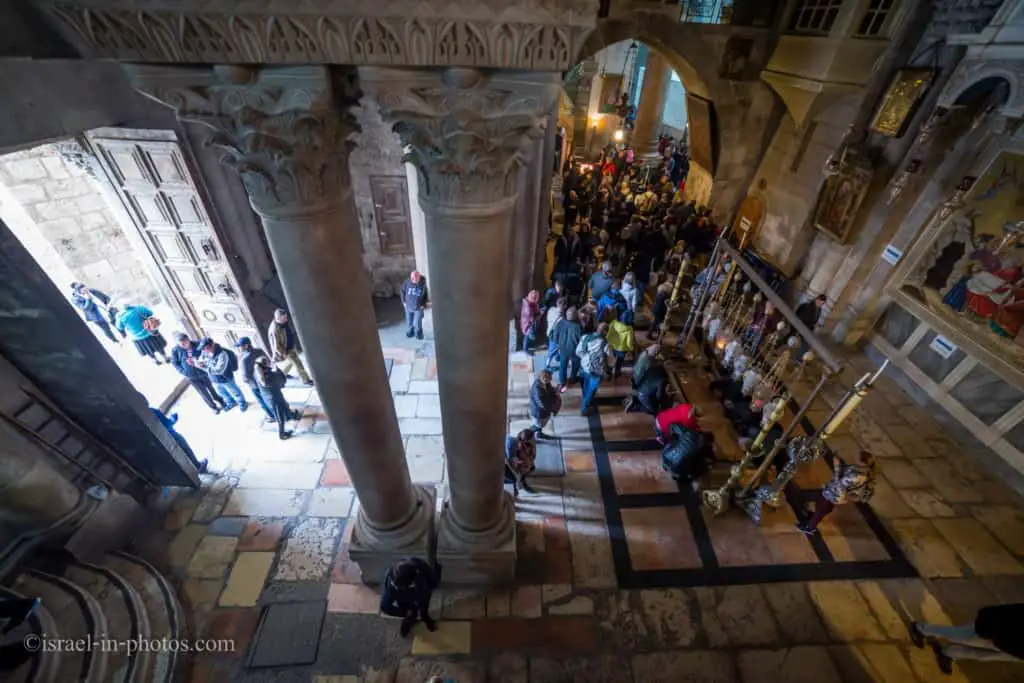
As you can see from the photo above, there is a corridor to the left of the Stone of Anointing. That corridor leads to the Rotunda and the Aedicule.
Rotunda and Aedicule
First, let’s start with a short explanation of a rotunda.
A rotunda is any building with a circular ground plan and sometimes covered by a dome. It can also refer to a round room within a building. The Pantheon in Rome is a famous rotunda.
Source: Wikipedia
Here is a broad view of the Rotunda.
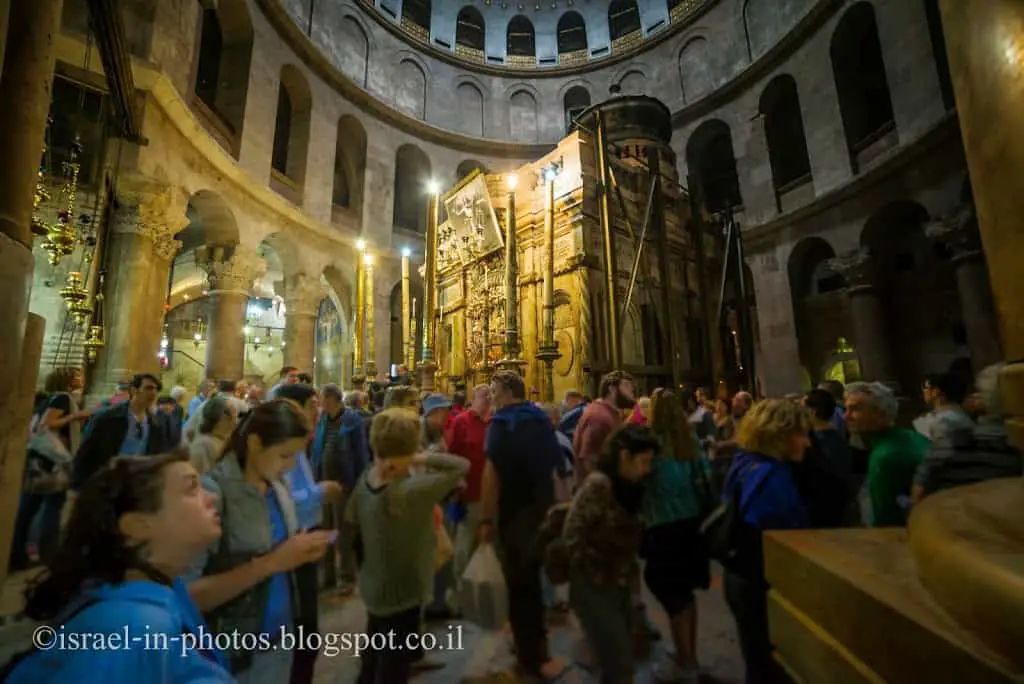
In the middle, you can see a small chapel. It is called the Aedicule, and it encloses the Holy Sepulchre.
In the center of the rotunda is a small chapel called the Kouvouklion in Greek or the Aedicula in Latin, which encloses the Holy Sepulchre. The Aedicule has two rooms, the first holding the Angel’s Stone, which is believed to be a fragment of the large stone that sealed the tomb; the second is the tomb itself. Possibly because pilgrims laid their hands on the tomb or to prevent eager pilgrims from removing bits of the original rock as souvenirs, a marble plaque was placed in the fourteenth century on the tomb to prevent further damage to the tomb.
Source: Wikipedia
Usually, there is a long line around the Rotunda to the Aedicule. Thus, if you want to Aedicule, come early.
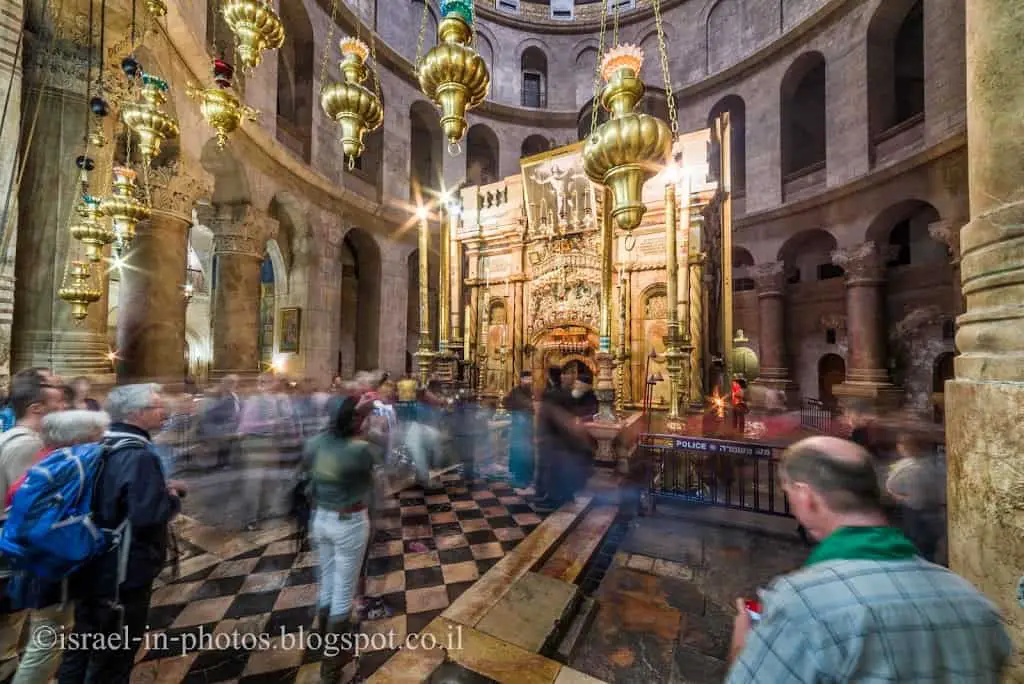
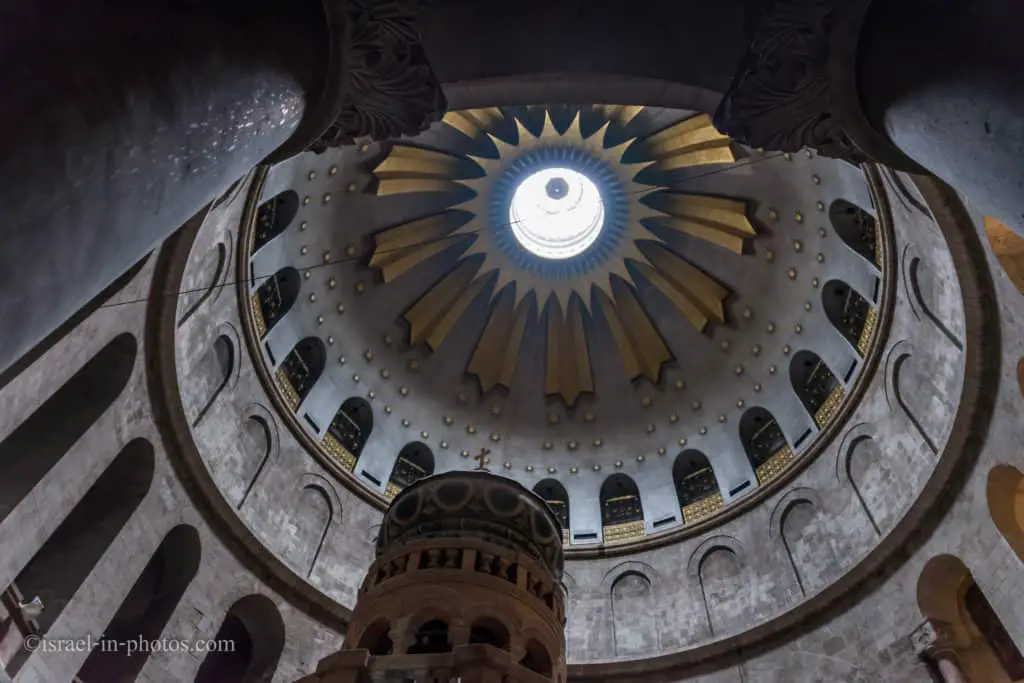
Lent Ceremonies
During one of our visits, we accidentally arrived at the Lent Ceremonies. And since most of the time I was near the Rotunda, I will now show several of my photos from the procession (the featured image is also from the lent ceremonies).
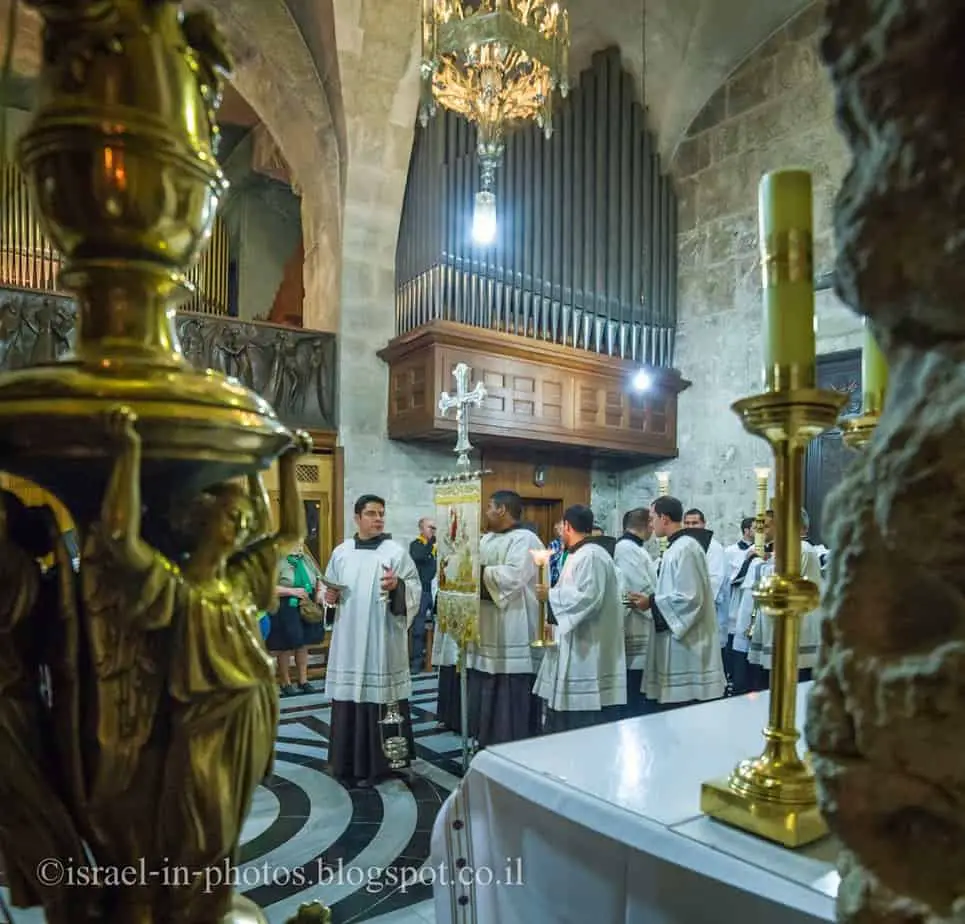
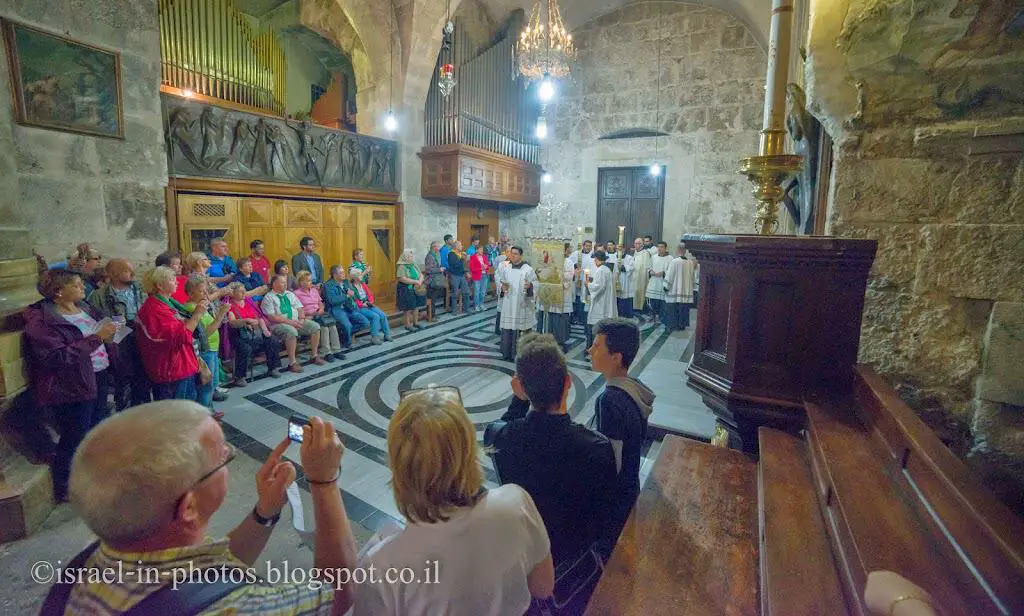
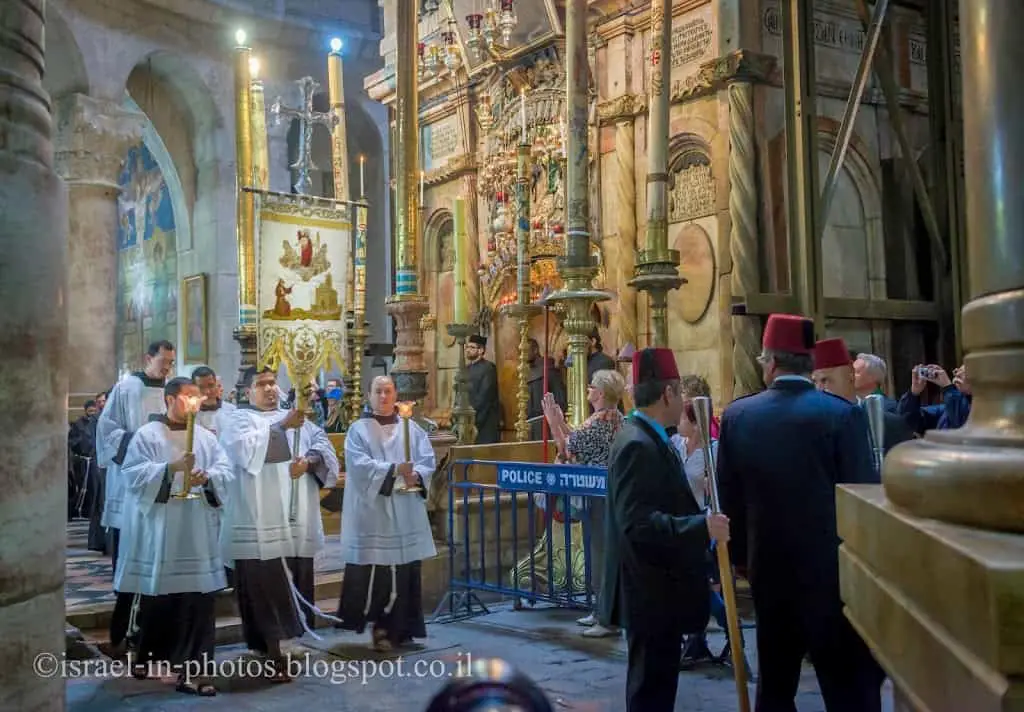
And here is how Lent Ceremonies looked from the outside:
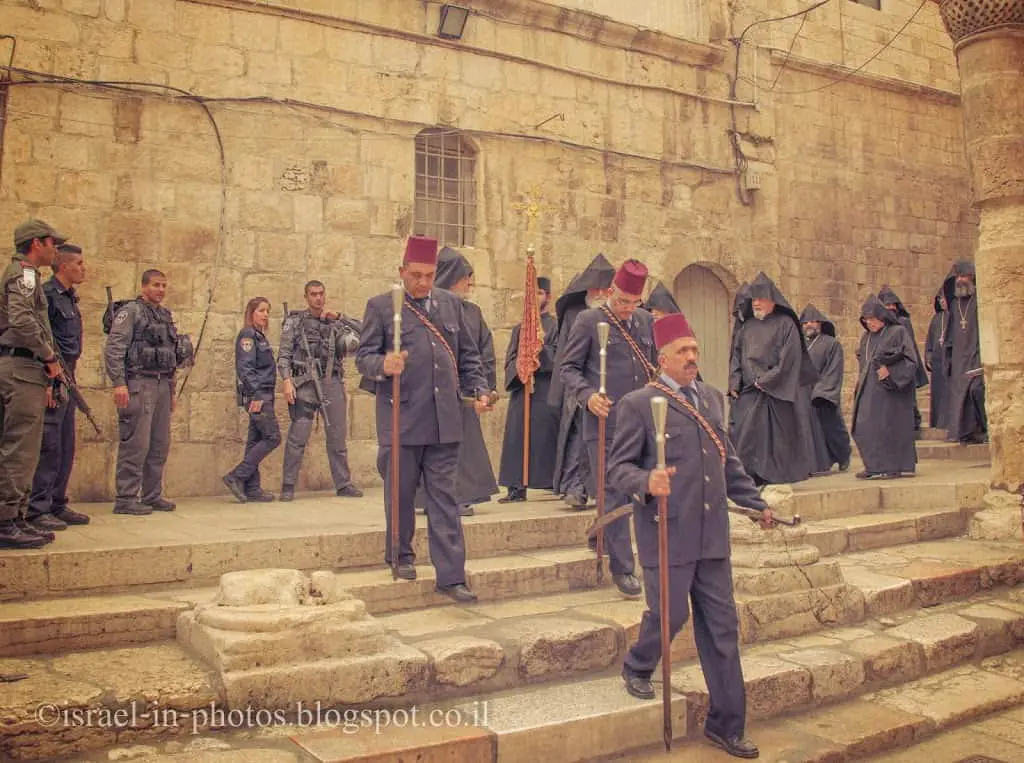
If you turn your back to the entrance to Aedicule, you will see the Catholicon.
Catholicon
In the central nave of the Crusader-era church, just east of the larger rotunda, is the Crusader structure housing the main altar of the Church, today the Greek Orthodox catholicon. Its dome is 19.8 meters in diameter and sits directly over the center of the transept crossing of the choir where the compass, an omphalos once thought to be the center of the world (associated with the site of the Crucifixion and the Resurrection), is situated.
Source: Wikipedia
In my recent visits, they started limiting the Catholicon entrance. So here is an earlier photo of the Catholicon.
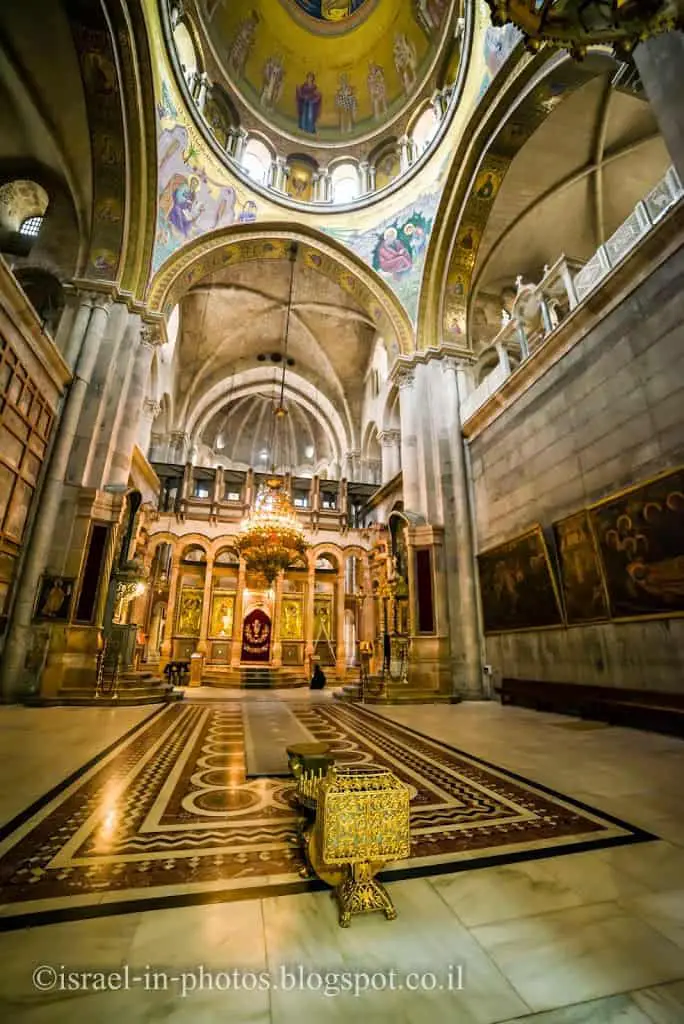
And if you stand in the center of the Catholicon and look up, you will see the “Christ Pantocrator” mosaic on the dome.
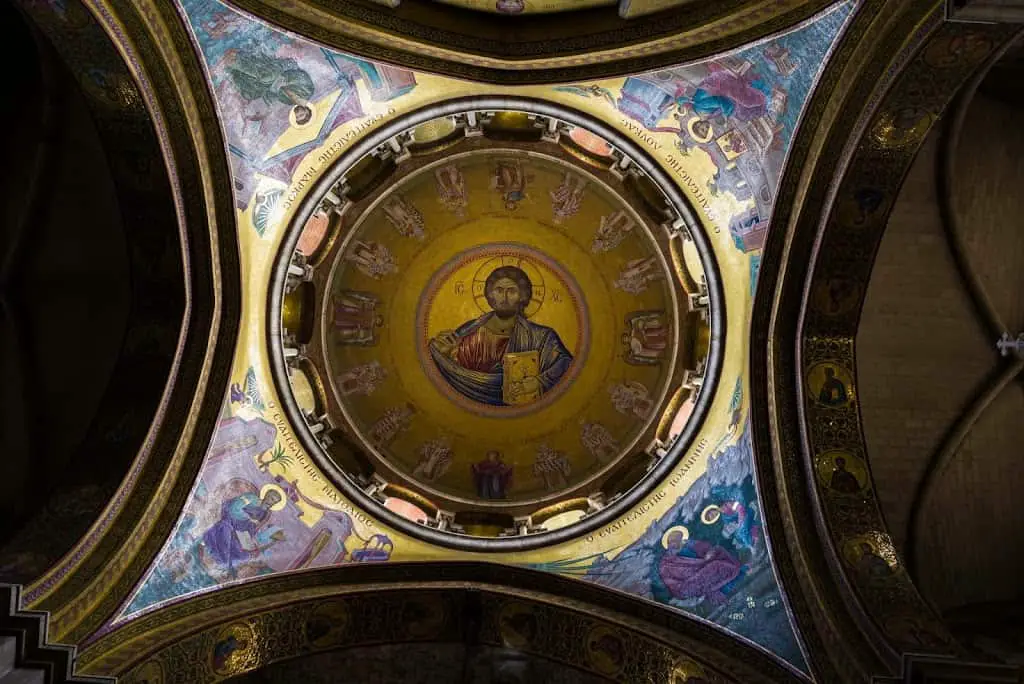
Let’s continue in the clockwise direction until we reach the stairs that lead down.
On your way, you will see a recently constructed chapel (see the following photograph), and nearby you can find newly built restrooms.

Lower Level
Your visit can begin by descending a flight of stairs whose walls are covered with crosses incised by hundreds of pilgrims over hundreds of years. Deep below ground level is the Armenian chapel, abutting a First Temple-period stone quarry where tradition says Queen Helene found the cross. The centerpiece of the main floor is the Edicule. Its icons and lanterns may be unfamiliar to some, but visitors often say they feel spiritually uplifted from the moments spent in the utter silence of the tiny interior room marking the traditional tomb.
Nearby is a stone slab where tradition says the body of Jesus was prepared for burial, and where you may see pious Orthodox and Catholic Christians praying fervently. Visitors are moved by the beautiful mosaic behind the stone, which shows with sadness and hope the moments when Jesus is taken down from the cross and laid in the tomb. Up a steep flight of stairs, the site of the Crucifixion itself is marked by both a Greek Orthodox and a Catholic altar, where Christians from around the world stand patiently in line waiting to touch the rock they hold sacred.
Visitors to the Church of the Holy Sepulchre find themselves steeped in the Christian history as well as experiencing living testimony to the tenacity of Christians to revere their piece of Jerusalem from the earliest times to the present.
Source: goisrael.com
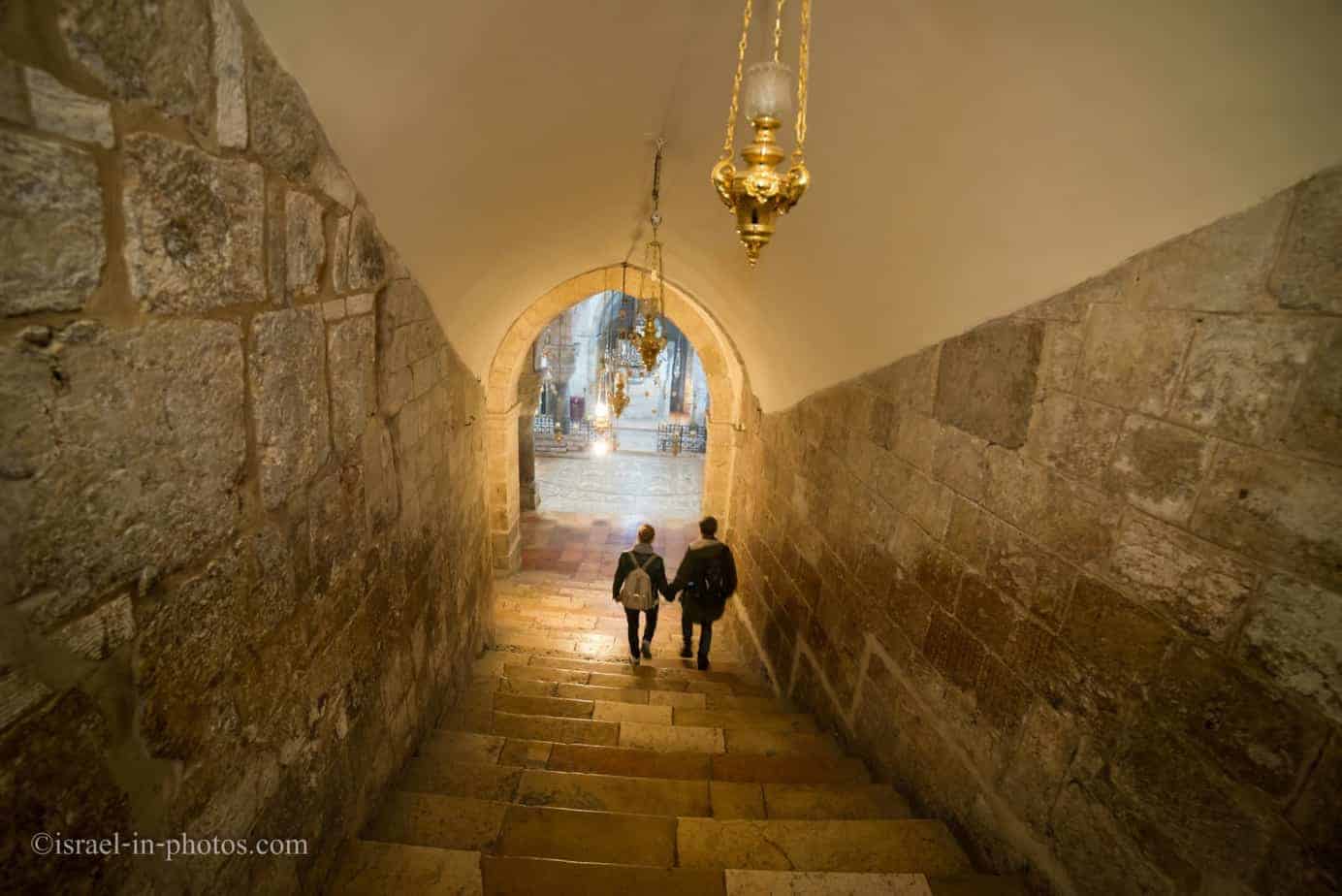
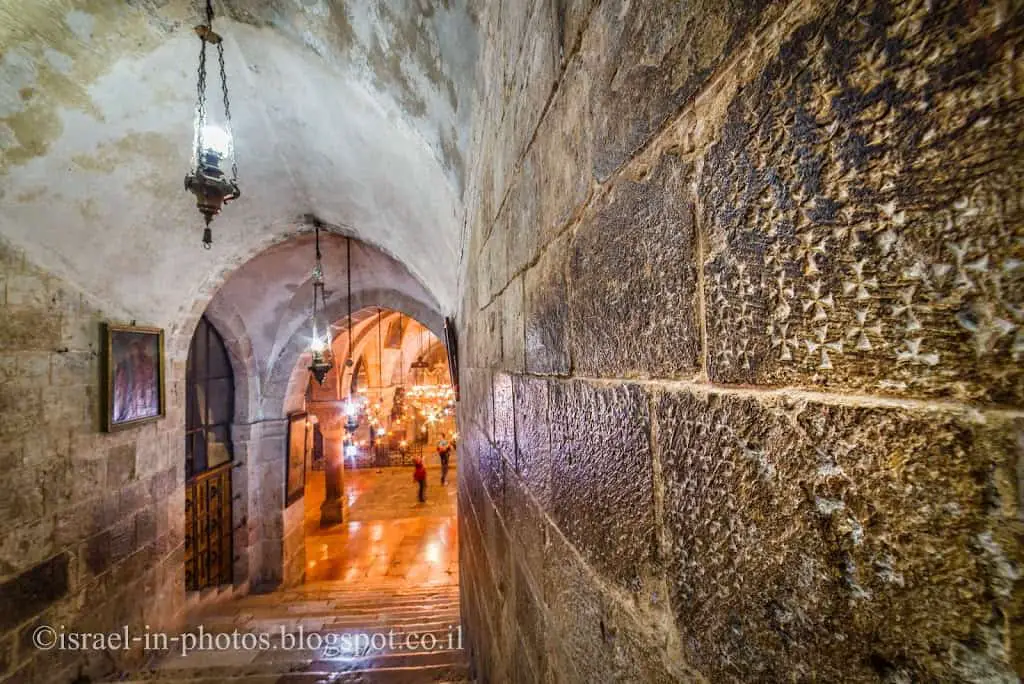
And if you take a look at the right wall along the stairs, you will see Crusader graffiti.
As you descend the stairs, you will enter the Chapel of Saint Helena.
Chapel of Saint Helena
Chapel of Saint Helena is a 12th-century Armenian church called after Helena, the mother of Emperor Constantine, who came here to find the True Cross.
– Chapel of Saint Helena – between the Chapel of Division of Robes and the Greek Chapel of the Derision are stairs descending to the Chapel of Saint Helena.
– Chapel of Vartan (or Vardan) Mamikonian – on the north side of the Chapel of Saint Helena is an ornate wrought iron door, beyond which a raised artificial platform affords views of the quarry, and which leads to the Chapel of Saint Vartan. The latter chapel contains archaeological remains from Hadrian’s temple and Constantine’s basilica. These areas are open only on request.
– Chapel of the Invention of the Holy Cross – another set of 22 stairs from the Chapel of Saint Helena leads down to the Roman Catholic Chapel of the Invention of the Holy Cross, believed to be the place where the True Cross was found.
Source: Wikipedia
Here are several photos of the Chapel Of Saint Helena.
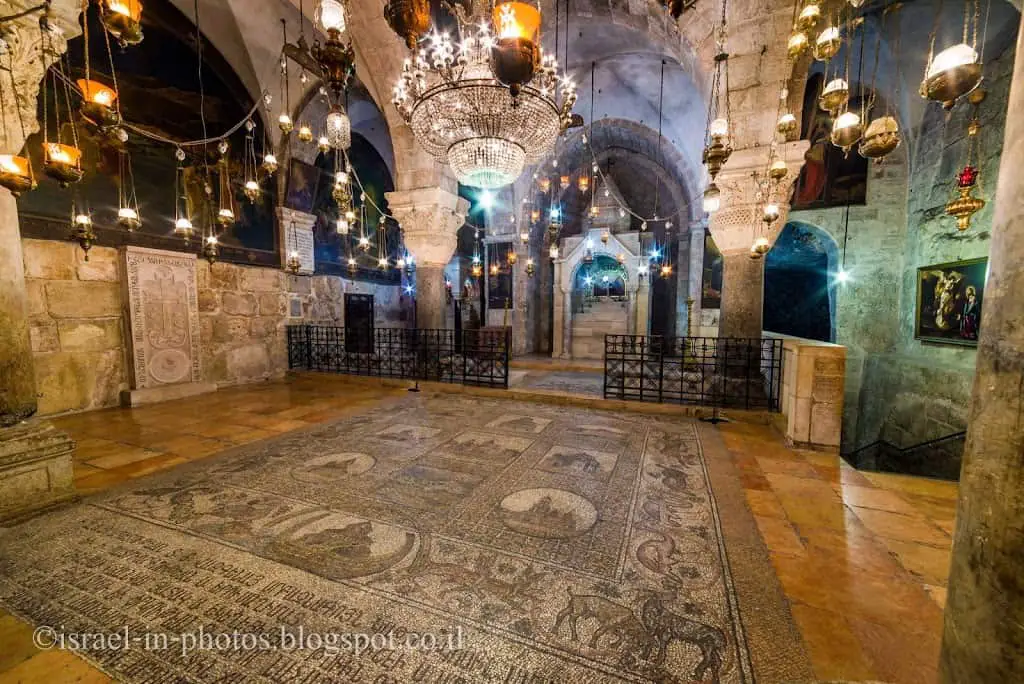
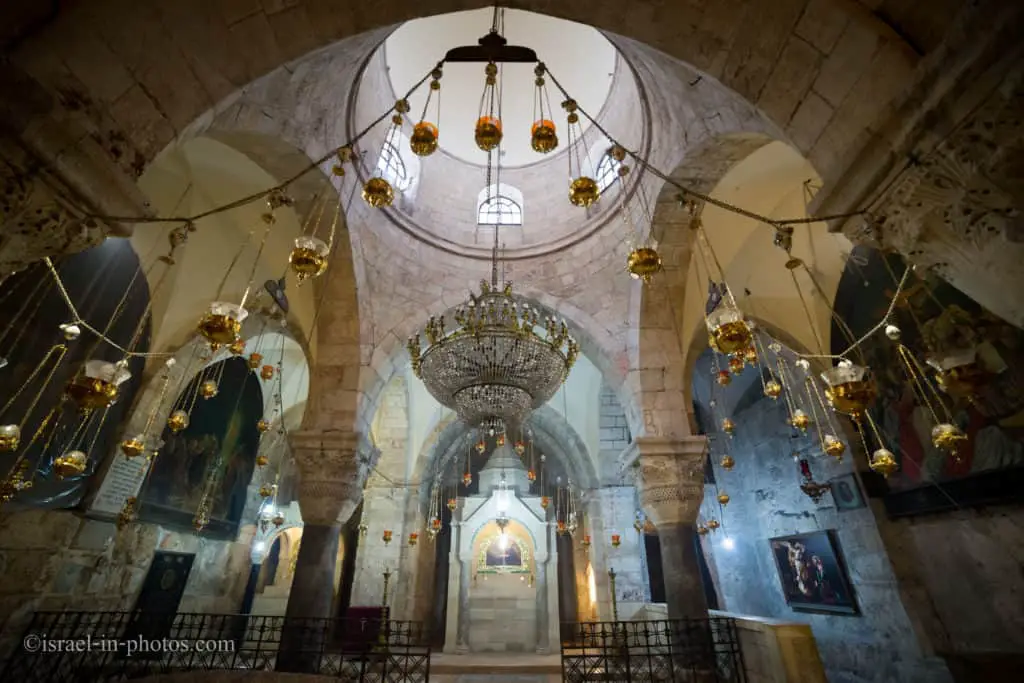
And now, let’s go back to the ground level and continue in a clockwise direction until we almost reach the Stone of Anointing. You will see the stairs to your left. And after you climb them, you will find yourself near Golgotha.
Golgotha – Calvary
According to the Gospels, Golgotha, or Calvary, was immediately outside Jerusalem’s walls where Jesus was crucified.
Matthew’s and Mark’s gospels translate the term to mean “place of [the] skull,” in Latin rendered Calvariæ Locus, from which the English word Calvary derives.
Calvary is split into two chapels, one Greek Orthodox and one Catholic, each with its altar. On the left (the north side), the Greek Orthodox chapel’s altar is placed over the rock of Calvary (the 12th Station of the Cross), which can be touched through a hole in the floor beneath the altar. The rock can be seen under protective glass on both sides of the altar. The softer surrounding stone was removed when the church was built. The Roman Catholic (Franciscan) Chapel of the Nailing of the Cross (11th Station of the Cross) stretches to the south. Between the Catholic and the Orthodox altar, a statue of Mary with an 18th-century bust marks the 13th Station of the Cross.
Source: Wikipedia
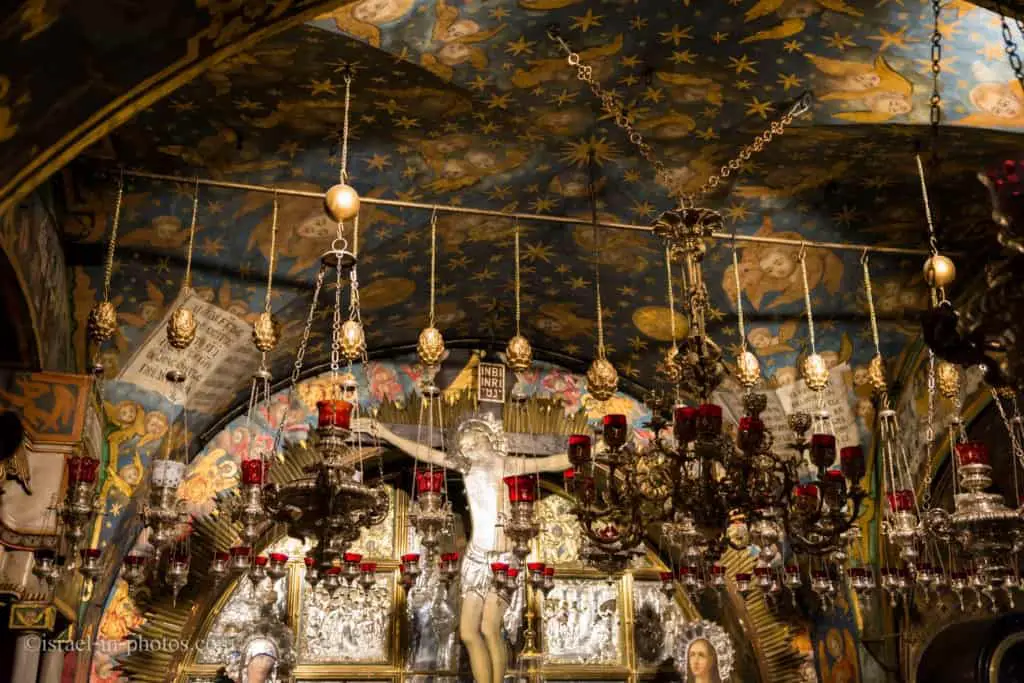
If you want to light candles near Golgotha or any other place in the Church Of The Holy Sepulchre, you can purchase them in the Old City’s market.
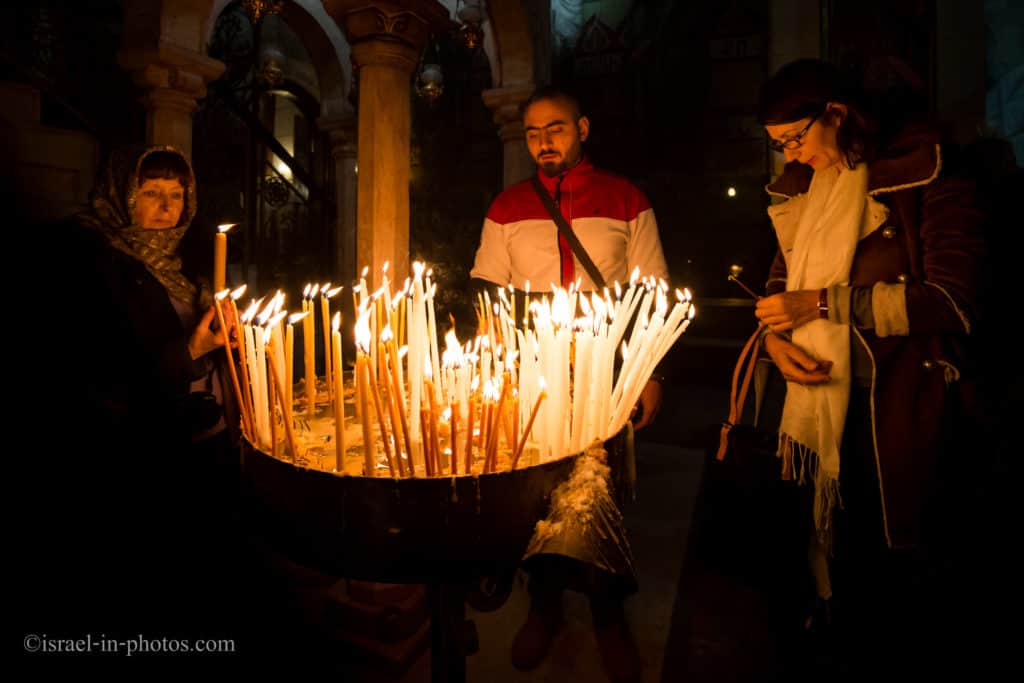
Golgotha concludes our visit to the church, and now we will address common questions.
Tours or Individual Visits?
In this guide, I covered the main parts and chapels of the church. But there are others as well. For example, there is the Prison of Christ and the Chapel of Adam. A regular visitor can miss many places and not know all of the church’s history.
At this point, you should decide whether you want a standard or an in-depth visit. If you want the standard one or are limited in time, then the information in this post should be enough. And if you prefer an in-depth tour, I suggest joining a tour or hiring a guide. Almost all tours at the Old City stop at the Church Of The Holy Sepulchre. Just ask them how much time you will spend inside the church (not including free time). Aim for at least one hour.
The problem with tours is that most of them are during midday. And earlier, I suggested visiting early (the earlier, the better). Thus, if you want an in-depth tour and visit the Aedicule, I recommend making two separate visits. First, start with a tour and learn about the church. Moreover, you might get lucky, and there will be no long line to the Aedicule, and you could visit the Holy Sepulchre at the same time. If not, make another early morning visit to the Aedicule and Golgotha.
How Much Time Does a Visit to the Church of the Holy Sepulchre Take?
The short answer is that it depends. It might be anywhere from half an hour to three hours. And I am not talking about guided tours, where the guide determines the duration of your visit.
The primary variable that affects your visit’s duration is the length of the lines. There are usually two queues – the longer one at the Aedicule and a short one at Golgotha. And at the Aedicule line, you can easily spend 2 – 3 hours (did I already say come early ;) ). And the Golgotha line usually takes up to 20 minutes. Beyond the queues, a typical visit will take 0.5 – 1.5 hours, depending on your interest in this site.
History
In this section, I will go over some of the historical highlights, and if you are interested in a complete version, you can find it on Wikipedia (the historical quotes were taken from there).
In 70 AD, the siege of Jerusalem by Emperor Titus saw the destruction of the Second Temple. Sixty years later, in 130 AD, the Roman emperor Hadrian started a Roman colony in Jerusalem and c. 135, ordered that a cave containing a rock-cut tomb be filled to create a flat foundation for a temple dedicated to Jupiter or Venus. The temple usually referred to as Jupiter Capitolinus, remained until the early 4th century.
Construction
After seeing a vision of a cross in the sky in 312, Constantine the Great converted to Christianity, signed the Edict of Milan legalizing the religion, and sent his mother Helena to Jerusalem to look for Christ’s tomb. With the help of Bishop of Caesarea Eusebius and Bishop of Jerusalem Macarius, three crosses were found near a tomb, leading the Romans to believe that they had found Calvary. Constantine ordered in about 326 that a church will replace Jupiter Capitolinus. After the temple was torn down and its ruins removed, the soil was removed from the cave, revealing a rock-cut tomb that Helena and Macarius identified as the burial site of Jesus, where a shrine was constructed around.
The church was consecrated on 13 September 335.
Damage, Destruction, And Reconstruction
This building was destroyed by a fire in May of 614 A.D when the Sassanid Empire under Khosrau II invaded Jerusalem and captured the True Cross. In 630, Emperor Heraclius rebuilt the church after recapturing the city. After Jerusalem came under Arab rule, it remained a Christian church, with the early Muslim rulers protecting the city’s Christian sites, prohibiting their destruction or use as living quarters. A story reports that the Caliph Umar ibn al-Khattab visited the church and stopped to pray on the balcony, but at the time of prayer, he turned away from the church and prayed outside. He feared that future generations would misinterpret this gesture, taking it as a pretext to turn the church into a mosque. Eutychius added that Umar wrote a decree prohibiting Muslims from praying at this location. The building suffered severe damage due to an earthquake in 746.
Church Of The Holy Sepulchre suffered from other disasters, like earthquakes and fires. And finally, in 1027-28, after negotiations between the Fatimids and the Byzantine Empire, an agreement was reached. According to the understanding, rebuilding and redecoration of the church were done.
Crusader Period
Many historians maintain that the main concern of Pope Urban II when calling for the First Crusade was the threat to Constantinople from the Turkish invasion of Asia Minor in response to the appeal of Byzantine Emperor Alexios I Komnenos. Historians agree that the fate of Jerusalem and thereby the Church of the Holy Sepulchre was of concern if not the immediate goal of papal policy in 1095. The idea of taking Jerusalem gained more focus as the Crusade was underway. The rebuilt church site was taken from the Fatimids by the First Crusade knights on 15 July 1099.
The First Crusade was envisioned as an armed pilgrimage, and no crusader could consider his journey complete unless he had prayed as a pilgrim at the Holy Sepulchre. Crusader Prince Godfrey of Bouillon, who became the first crusader monarch of Jerusalem, decided not to use the title “king” during his lifetime and declared himself “Advocatus Sancti Sepulchri” (“Protector [or Defender] of the Holy Sepulchre”). By the crusader period, a cistern under the former basilica was rumored to have been the location where Helena had found the True Cross. And it began to be venerated as such. Although the cistern later became the “Chapel of the Invention of the Cross,” there is no evidence of the rumor before the 11th century. Modern archaeological investigation has now dated the cistern to 11th-century repairs by Monomachos.
William of Tyre, the chronicler of the Crusader Kingdom of Jerusalem, reports on the renovation of the Church in the mid-12th century. The crusaders investigated the eastern ruins on the site, occasionally excavating through the rubble, and while attempting to reach the cistern, they discovered part of the original ground level of Hadrian’s temple enclosure; they decided to transform this space into a chapel dedicated to Helena (the Chapel of Saint Helena), widening their original excavation tunnel into a proper staircase. The Crusaders began to refurbish the church in a Romanesque style and added a bell tower.
The renovations continued until the Khwarezmians captured both the city and the church in 1244.
Ottoman And Later Periods
The Franciscan friars renovated the church in 1555, as it had been neglected despite increased numbers of pilgrims. The Franciscans rebuilt the Aedicule, extending the structure to create an antechamber. A marble shrine commissioned by Friar Boniface of Ragusa was placed to envelop the remains of Christ’s tomb, probably to prevent pilgrims from touching the original rock or taking small pieces as souvenirs. A marble slab was placed over the limestone burial bed where Jesus’s body is believed to have lain.
After the renovation of 1555, control of the church oscillated between the Franciscans and the Orthodox, depending on which community could obtain a favorable firman from the “Sublime Porte” at a particular time, often through outright bribery, and violent clashes were not uncommon. There was no agreement about this question, although it was discussed at the negotiations to the Treaty of Karlowitz in 1699. In 1767, weary of the squabbling, the “Porte” issued a firman divided the church among the claimants.
Summary
Church Of The Holy Sepulchre is a must-stop in the Old City of Jerusalem. It is not only a holy place but also a historical and archeological site. Thus, I would recommend everybody to visit it.
Have you ever been to the Church Of The Holy Sepulchre? Tell us about your experience in the comments below.
For additional nearby attractions, see Jerusalem.
That’s all for today, and I’ll see you in future travels!
Stay Tuned!
Additional Resources
Here are several resources that I created to help travelers:- Trip Planner with Attractions and Itineraries is the page that will help you create your perfect travel route.
- What is the Best Time to visit Israel? To answer this question, we will consider the weather, prices, holidays, festivals, and more.
- Information and Tips for Tourists to Israel will answer the most common questions tourists have about Israel (including safety, passports, weather, currency, tipping, electricity, and much more).
- Israel National Parks and Nature Reserves include a complete list, top ten, map, tickets (Israel Pass, Matmon, combo), and campsites.
- If you are looking for things to do, here are the pages for Jerusalem, Tel Aviv, Haifa, Sea Of Galilee, Akko (Acre), Eilat, Nazareth, Safed (Tzfat), and Makhtesh Ramon.

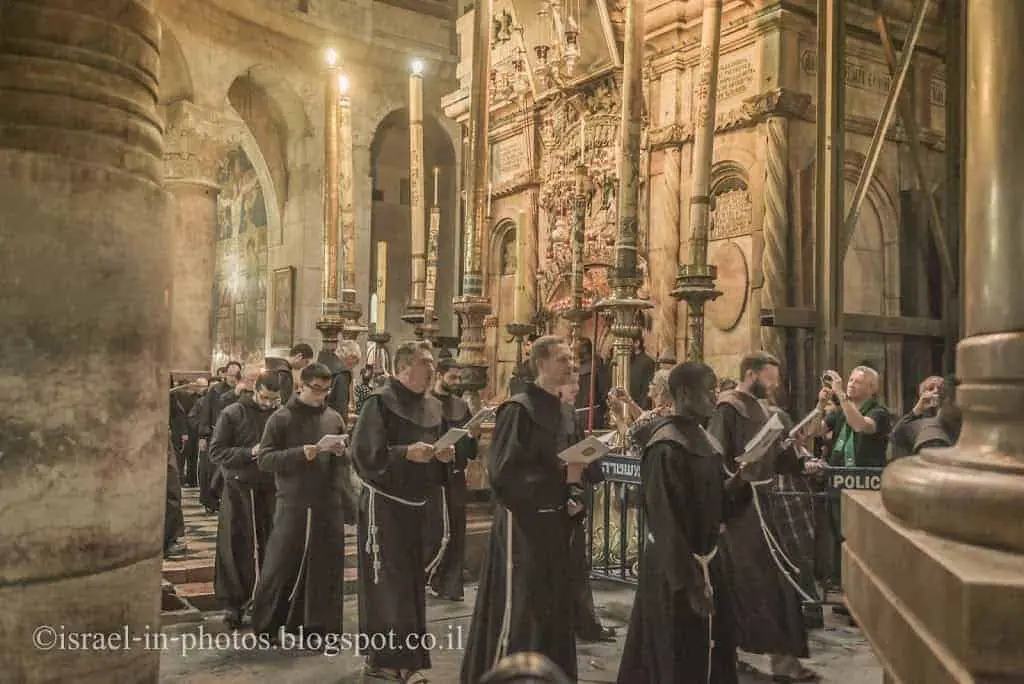
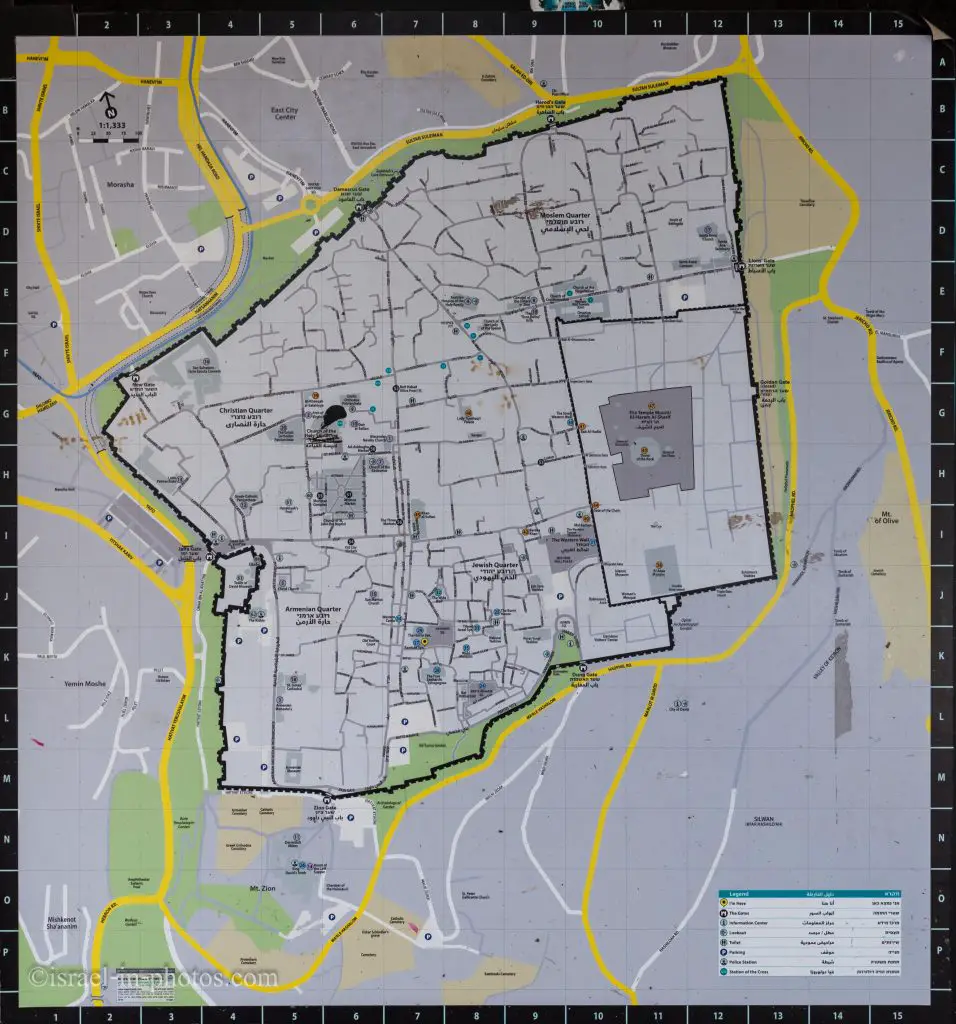

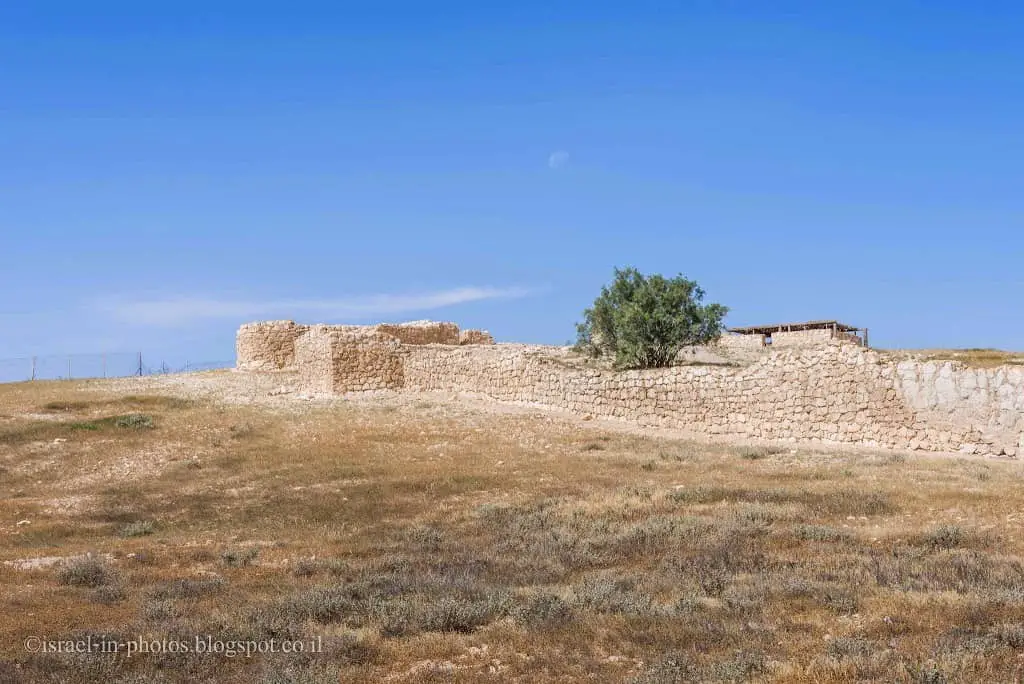


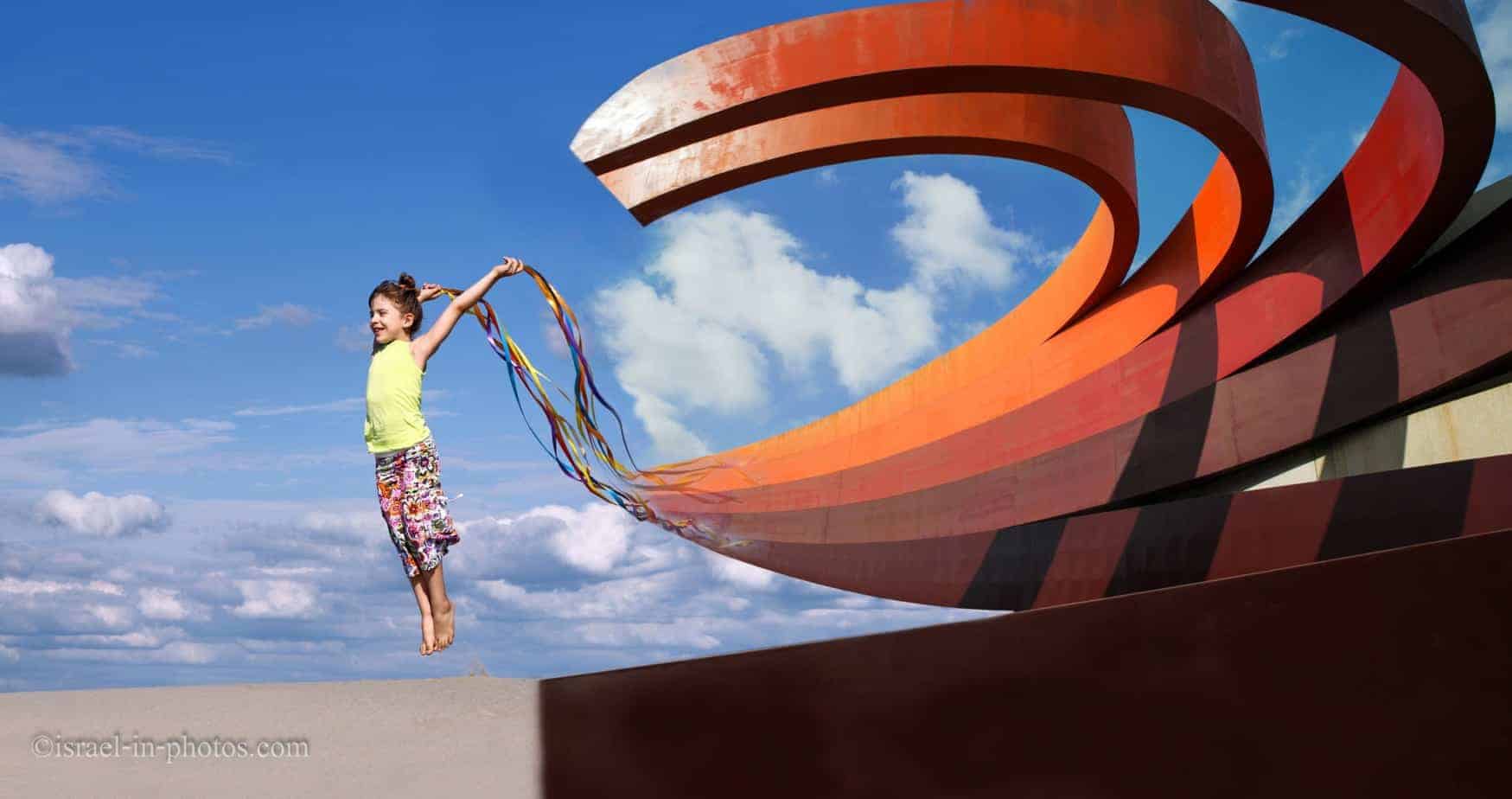

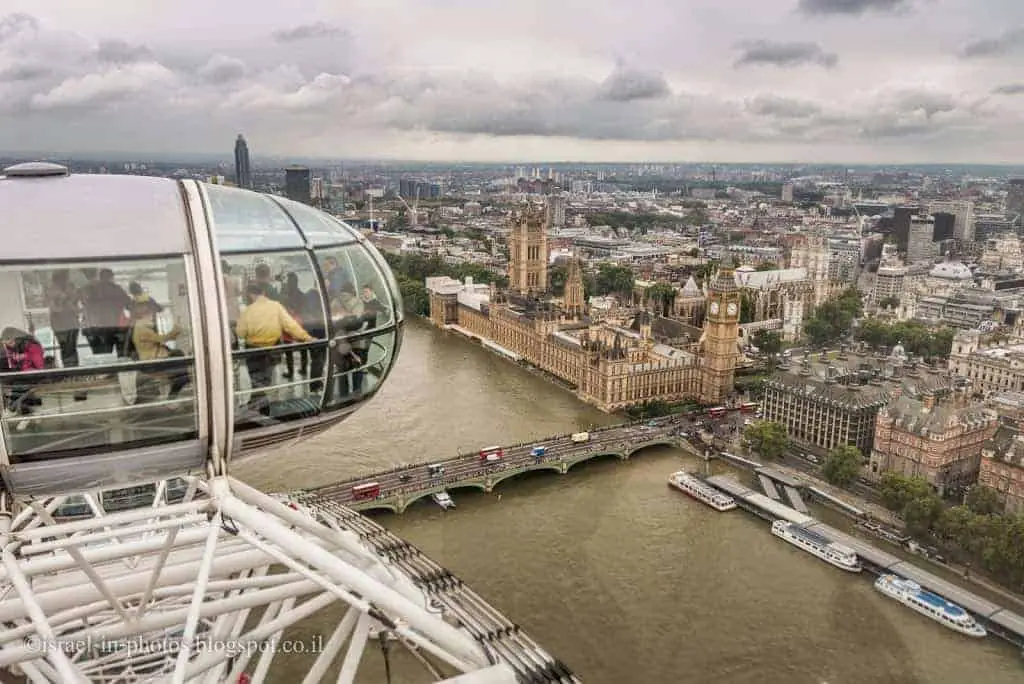
who was said to be buried in the small tomb/burial cave 30-40 feet away from jesus tomb? i cant find the answer! thanks.
pete
Hi Pete,
This is probably what you are looking for:
https://www.youtube.com/watch?v=sDfjMlF54w8&ab_channel=TheHolyLandChannelbyZahiShaked